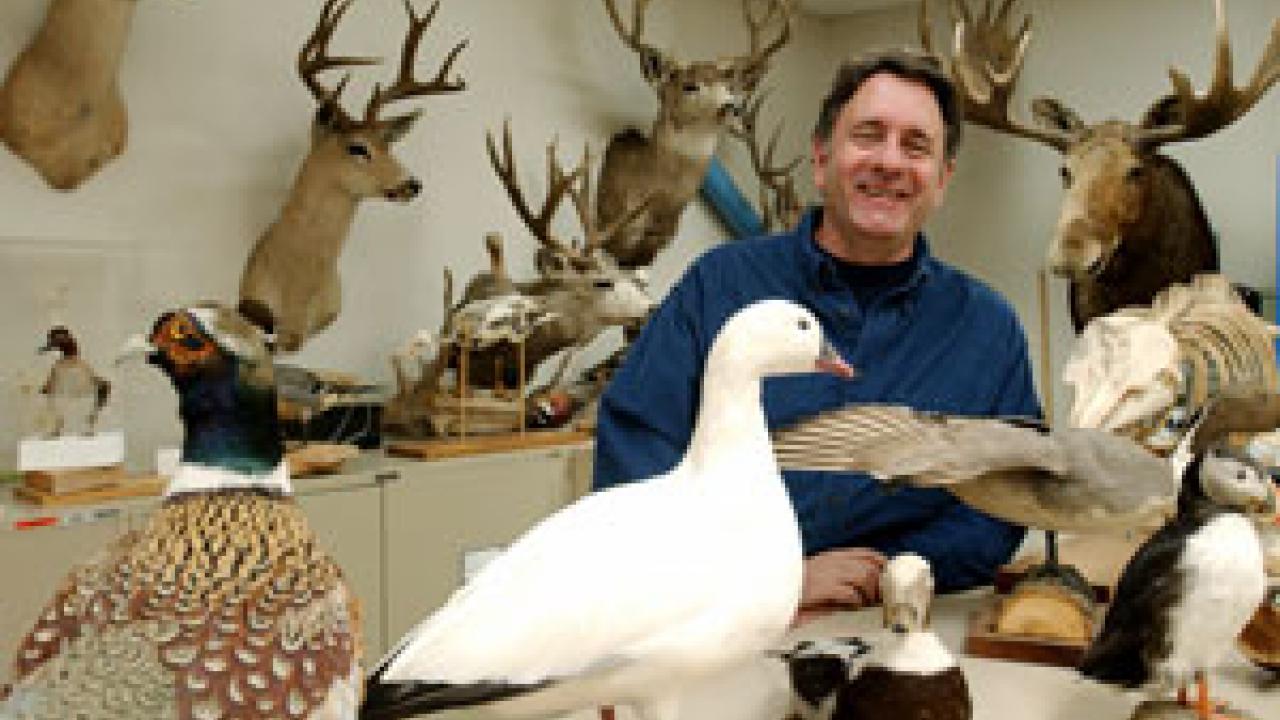While traveling around the world in the name of science, he's dangled off the side of a helicopter 1,200 feet in the air, nearly been swept away by a flooding river and been held at spear point in the rainforest of New Guinea. Indiana Jones in the flesh, you say?
Try Andy Engilis, curator of the campus's Museum of Wildlife and Fish Biology.
Engilis, a bird specialist, or ornithologist, in the Department of Wildlife, Fish and Conservation Biology, has been taken by his research to New Guinea, Hawaii, Chile and Belize as well as New Zealand. Spending months isolated in foreign countries has given Engilis an endless supply of stories to tell.
"There are lots of little adventures in the field," he says.
That is, if you call being surrounded by a dozen spear-wielding New Guineans dressed in full war regalia "little." While doing field research in New Guinea in the mid-1980s, Engilis was caught in the middle of massive rioting after the death of a popular leader. After being captured, he managed to talk his way out almost unscathed.
"I still have a dent in my forehead where they poked me with a spear," he says, pointing above his eyes.
Another of Engilis' "little adventures" happened while he was working in a remote mountainous area in Molokai, Hawaii. He and a colleague were on top of a 1,200-foot ridge loading a helicopter hovering at zero altitude when a gust of wind blew the helicopter off the ridge. Engilis managed to grab onto the side of the helicopter as it blew off, and hung on until the chopper could return him to safety.
"The pilot looked over and mouthed, 'hold on,'" Engilis recalls, "and I yelled,'Don't worry!' After that, they called me 'Opihi'-- a type of abalone that sucks onto a rock."
Even when he's not risking his life, Engilis finds plenty to do.
Since 2000, he has headed a museum of more than 30,000 specimens of birds, mammals and fish. It's the third-largest university collection in the state.
Engilis, who graduated with a degree in avian science from UC Davis in 1982, oversees a museum staff of three to preserve and curate the specimens used for teaching and loans to agencies and independent researchers. Although many animals in the museum are acquired from animal rehab centers or other museums around the country, Engilis also runs expeditions to find new specimens.
Apart from his museum work, Engilis is studying the endangered Hawaiian duck and community ecology of Chilean birds. He's also working on describing a new species of bird he discovered in New Guinea.
Engilis also helped establish a bioinventory team in the museum that has been contracted by several state agencies to assess the biodiversity of several local ecosystems, including Putah Creek and the Yolo Bypass.
How did you get into the conservation field?
Where I grew up, in Foothill Farms (North Sacramento), there was a creek called Magpie Creek. I can remember to this day when the bulldozers moved in and put Magpie Creek underground in a number of weeks, and the houses started going up. The creek was where I started bird watching at age 11, and began my observations of the natural world; losing it was a defining moment for me.
What is your guilty pleasure?
Travel. My job has always carried me around the world, and it's made me want to go on my own to other places. I remember my first non-job-related trip was to Ecuador to bird watch. After five or six days in the Amazon, I realized what a high level of peace of mind I had. I try to do that every once in a while now.
What's your most treasured possession?
My binoculars. I can't go anywhere without them. They're a part of my job and my bird-watching hobby.
What's something surprising about you?
I'm a big "Star Trek" fan, a borderline Trekkie. I just got the original series on DVD so I've been reliving my childhood. I identify with Captain Kirk, being out in the middle of nowhere and having to make life-or-death decisions. Although I never had a Mr. Spock to tell me the logical choices.
Who inspires you?
Ron Cole, the museum's previous curator and now an emeritus. I worked for him as an undergrad. His philosophies and ways of dealing with people have inspired me over the years, as well as his cross-training in birds and mammals. It is an honor to follow in his footsteps. •
Media Resources
Amy Agronis, Dateline, (530) 752-1932, abagronis@ucdavis.edu
